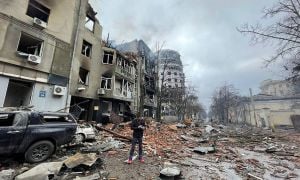New Delhi, the capital of India, is grappling with one of its most severe air quality crises to date, compelling the government to declare a medical emergency. On November 18, 2024, the Air Quality Index (AQI) reached alarming levels, peaking at 484—classifying it as "severe plus"—and featuring particulate matter (PM 2.5) concentrations dramatically above recommended safety limits set by the World Health Organization.
This crisis has direct consequences for the city's approximately 55 million residents. With air quality deteriorated to such extremes, officials have announced the closure of educational institutions and strongly advised the population to remain indoors to avoid health complications, particularly for sensitive groups like children, the elderly, and those with pre-existing health conditions. The Chief Minister of Delhi, Atishi Marlena Singh, has indicated the primary driver of this pollution catastrophe stems from stubble burning practices prevalent across neighboring states, particularly Punjab and Haryana.
Experts highlight the severity of the air quality, drawing comparisons between inhaling the toxic smog and smoking 30 to 40 cigarettes each day. With this incessant smog expected to linger for several days more, health advisories urge residents to take precautionary measures seriously.
The impact of this environmental hazard is not only felt physically but also economically. Small and medium-sized enterprises (MSMEs) across Delhi and nearby regions report heavy disruptions, struggling to maintain normal operations under the haze of pollution. The cold winter air trapping these contaminants exacerbates the issue, one key factor contributing to the grim air quality statistics. Reports indicate the famous Taj Mahal’s visibility has been severely diminished due to the persistent fog, which is emblematic of the broader crisis.
This troubling phenomenon has been identified as seasonal, with predictions for worsening conditions as winter progresses. Such weather patterns create what can effectively be described as pollution inversion layers, keeping harmful particles trapped close to the ground.
To combat this situation, New Delhi’s administration has initiated emergency measures, which include restrictions on vehicular traffic and construction activities across the city. Given the levels of dangerous pollutants being consistently recorded, there is widespread concern and criticism directed toward the local government’s response to this recurring problem—a scenario experts say was foreseeable.
It is important to note the broader ramifications of pollution are not confined to health; they seep deep within the socio-economic fabric of the region. Industries and schools have switched to online operations or laid off workers due to safety concerns, illustrating just how intertwined public health and economic viability can be.
While authorities scramble to mitigate the current crisis, public impatience mounts over what many perceive as piecemeal solutions rather than systemic change. Environmental activists have long advocated for more rigorous regulations governing farming practices such as burning stubble and vehicle emissions, which contribute heavily to air pollution.
Both local and environmental organizations are calling for governmental accountability and proactive measures to curb the pollution epidemic. They stress the need for comprehensive urban planning efforts combined with strict penalties for non-compliance with air quality standards to prevent these catastrophic pollution episodes from recurring.
Although some measures—such as investment in greener technology, stricter enforcement of pollution control regulations, and public awareness campaigns—are underway, many believe these steps are insufficient. They argue for more drastic actions to facilitate faster transitions to sustainable practices across key sectors driving pollution.
The plight of New Delhi serves as both a cautionary tale and a pressing reminder of the urgent need for action to protect public health and the environment. Until substantial changes are made on both governmental and collective fronts, the city could find itself facing similar crises again and again.
Delhi’s public health crisis, underscored by the suffocative smog enveloping its streets, is emblematic of larger environmental issues afflicting urban centers globally. The struggles of its residents to breathe clean air represent not just a local challenge but one faced by many major cities worldwide.
For the time being, residents, lawmakers, and environmentalists alike will be watching closely for any actionable strategies presented by government bodies, hoping they will prioritize the well-being of millions over profit and convenience. Public life, health, and the future of Delhi depend on it.



